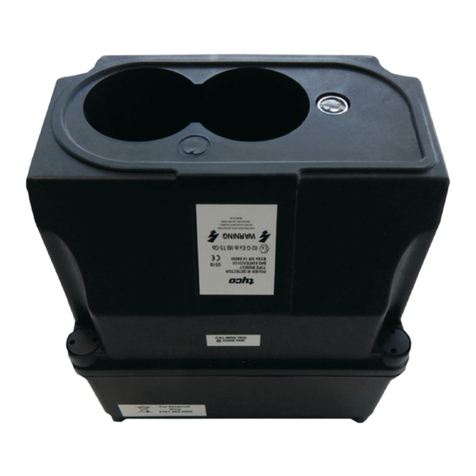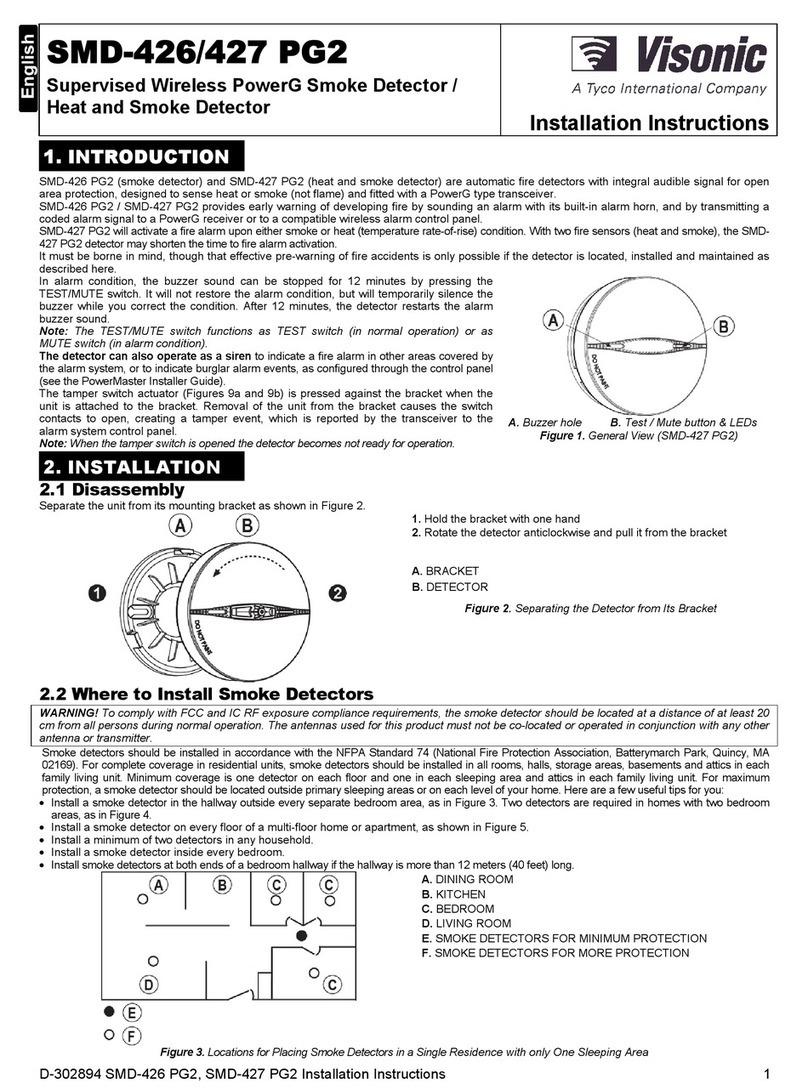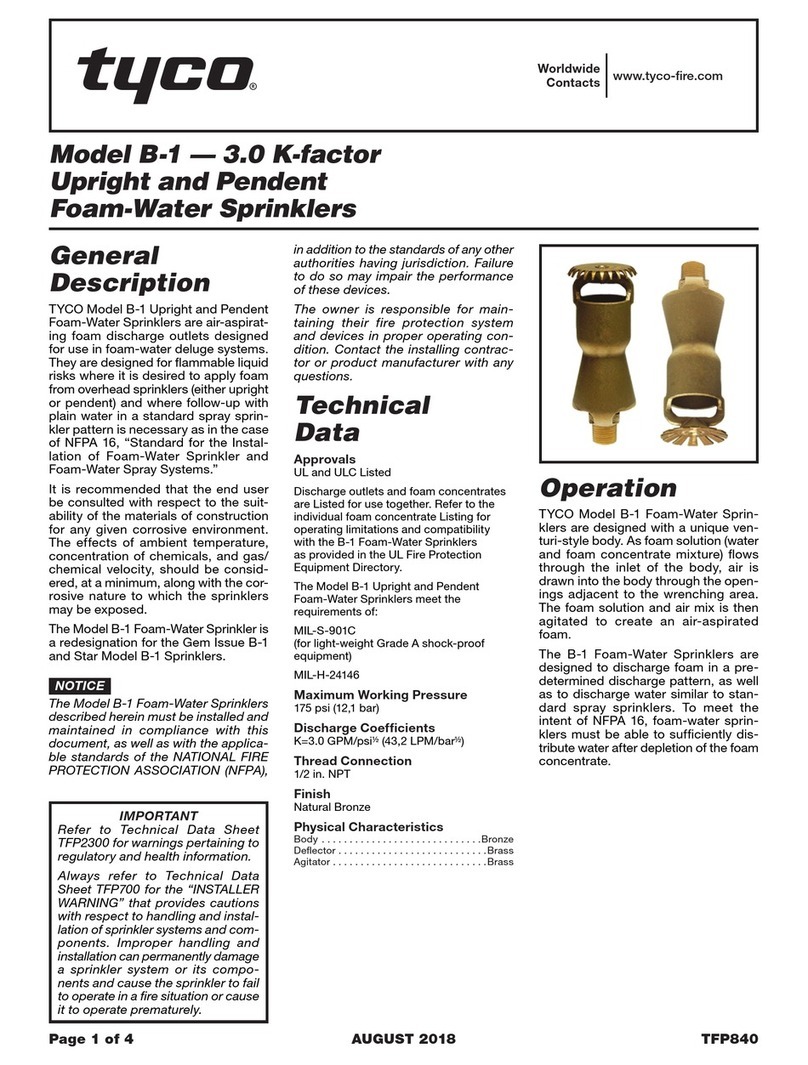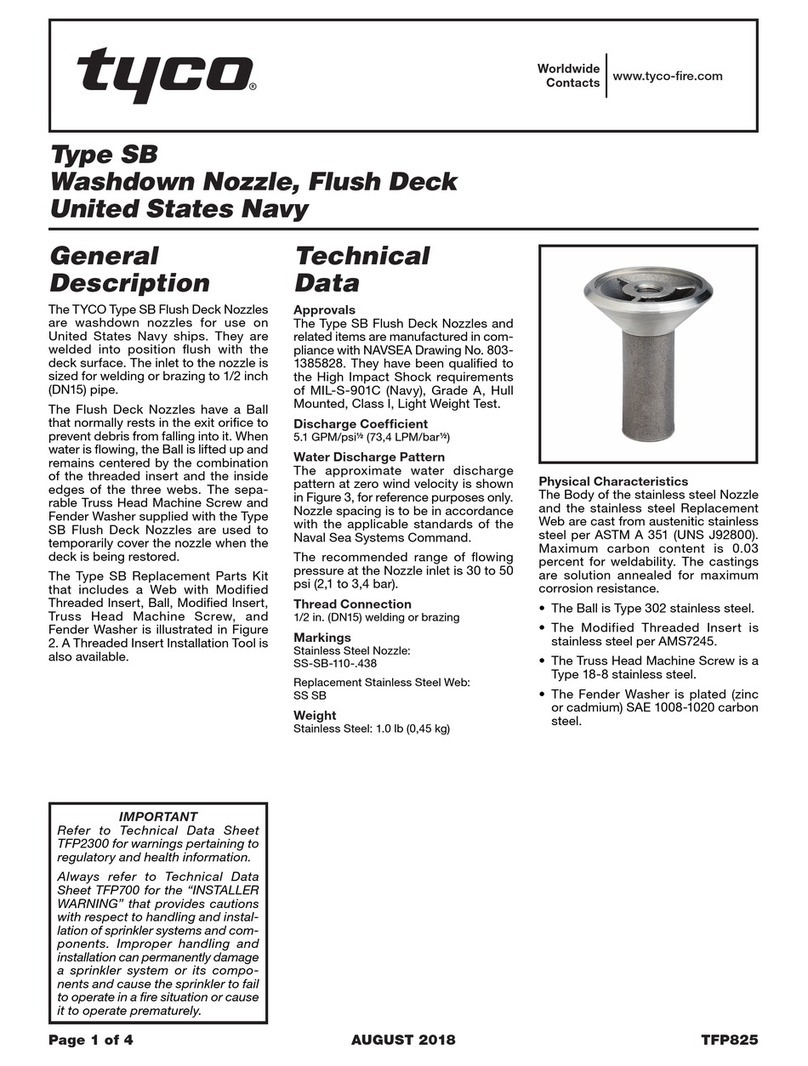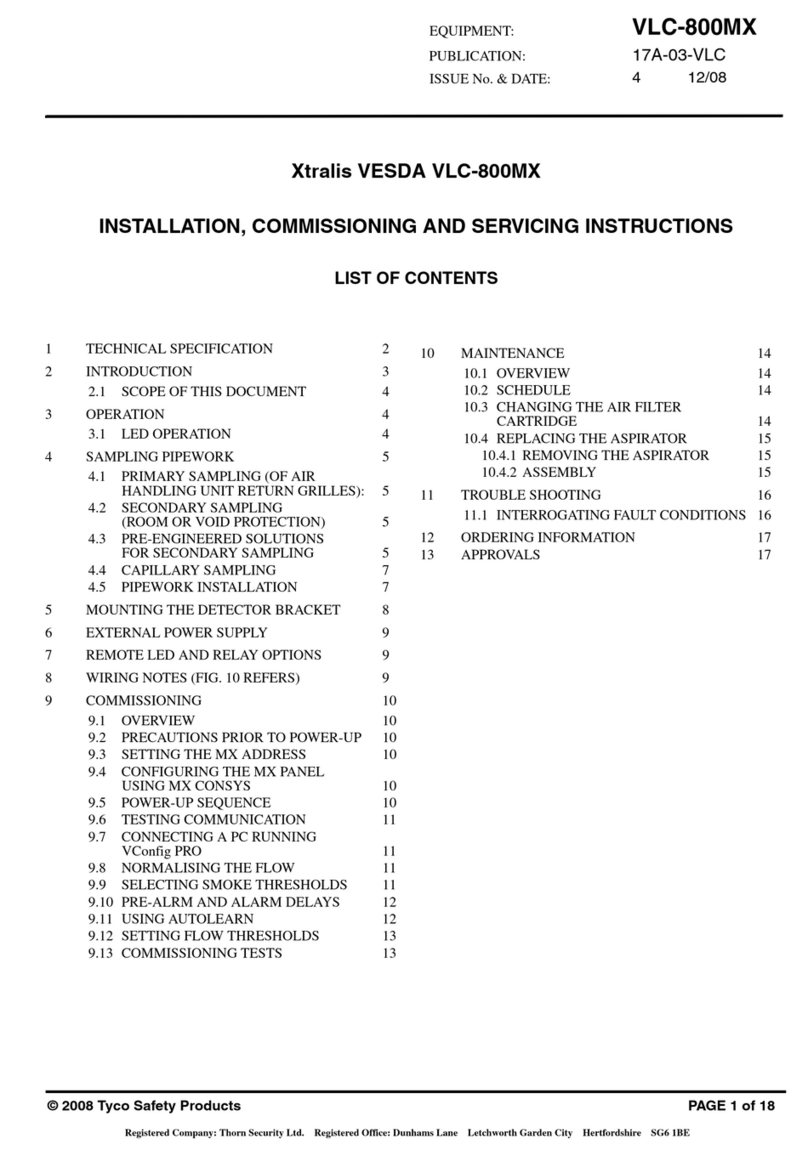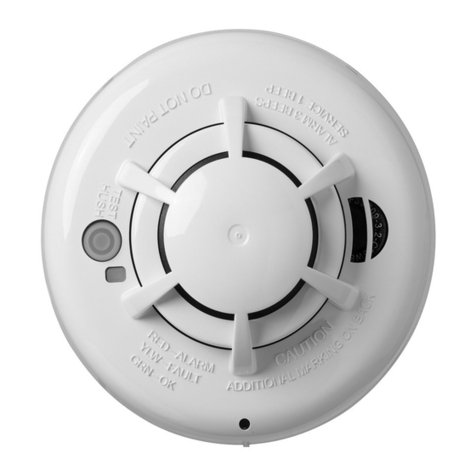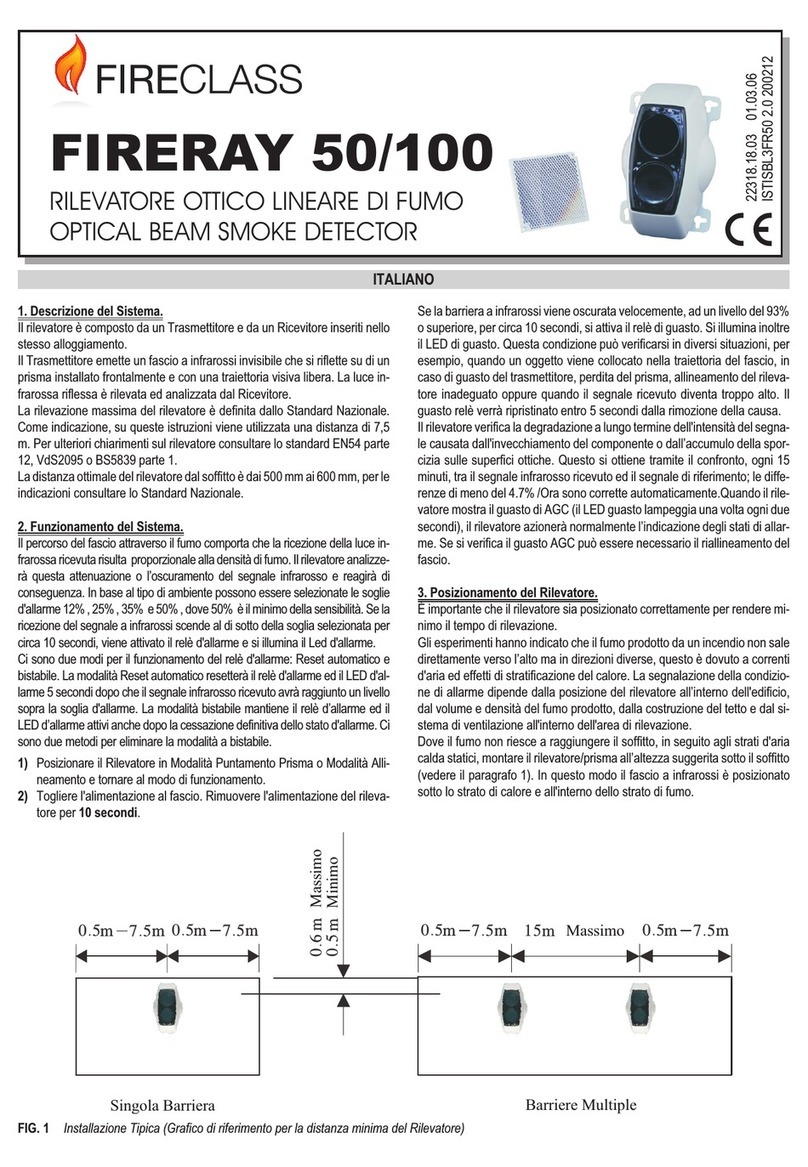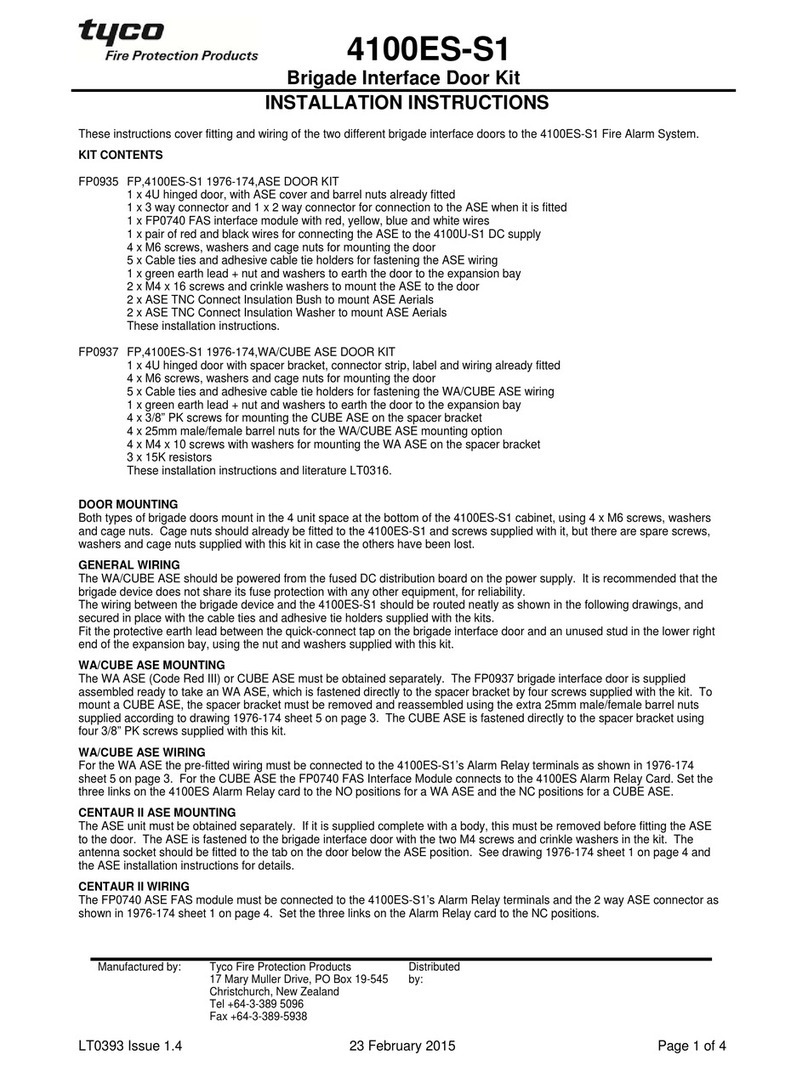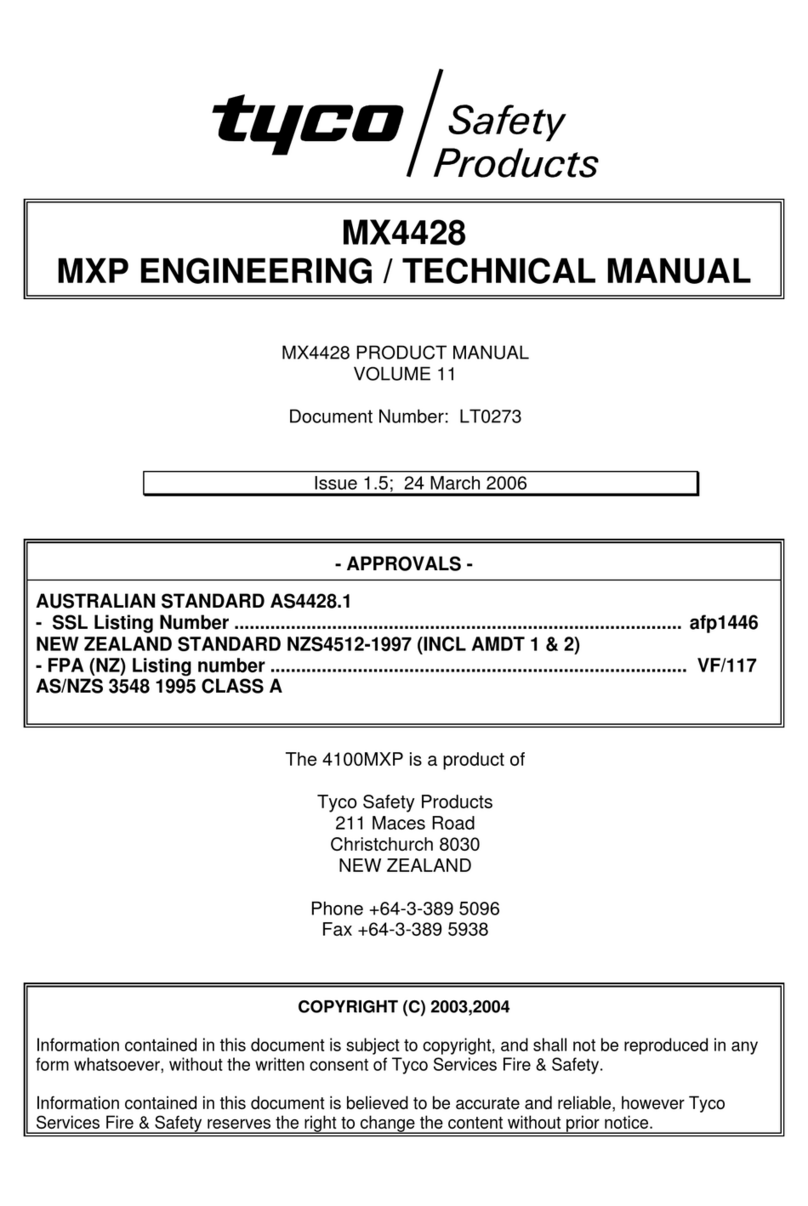
Smoke Detector Family
Specifications
NOTE: If this detector is used with compatible VISTA series
control panels:
• Set zone debounce time at the maximum of 1.2 seconds
• Consult the Control Unit Installation Manual for additional
compatibility information and limitations. All instructions
specified within that manual must be observed. The DSC
PRM-2W provides an interface for control panels that do
not have a compatible 2-wire smoke detector zone.
• The maximum number of DSC Model FSD-210B series of
detectors connected to the two wire smoke interface
should be limited to 5. If the installation requires the use of
more devices on the two wire loop and alarm interconnect
is not required, please use the DSC Model PRM-2W(C)
Reverse Polarity Module (please refer to the PRM-2W(C)
installation instructions for further information). If the instal-
lation requires more devices and alarm interconnect is
required, we recommend installing FSA-210 series detec-
tors.
FCC Compliance Statement
CAUTION: Changes or modifications not expressly approved by DSC could void your
authority to use this equipment.
This equipment has been tested and found to comply with the limits for a Class B digital device, pur-
suant to Part 15 of the FCC Rules. These limits are designed to provide reasonable protection against
harmful interference in a residential installation. This equipment generates, uses and can radiate radio
frequency energy and, if not installed and used in accordance with the instructions, may cause harm-
ful interference to radio communications. However, there is no guarantee that interference will not
occur in a particular installation. If this equipment does cause harmful interference to radio or televi-
sion reception, which can be determined by turning the equipment off and on, the user is encouraged
to try to correct the interference by one or more of the following measures:
• Re-orient the receiving antenna.
• Increase the separation between the equipment and receiver.
• Connect the equipment into an outlet on a circuit different from that to which the receiver is con-
nected.
• Consult the dealer or an experienced radio/television technician for help.
The user may find the following booklet prepared by the FCC useful: “How to Identify and Resolve
Radio/Television Interference Problems”. This booklet is available from the U.S. Government Print-
ing Office, Washington D.C. 20402, Stock # 004-000-00345-4.
Industry Canada Compliance Statement
This Class B digital apparatus meets all requirements of the Canadian interference-causing equip-
ment regulations.
Cet appareil numérique de la Classe B respecte toutes les exigences de règlement sur le matériel
brouilleur du Canada.
IMPORTANT - READ CAREFULLY: DSC Software purchased with or without Products and Components is copyrighted and is purchased
under the following license terms:
• This End-User License Agreement (“EULA”) is a legal agreement between You (the company, individual or entity who acquired the Software and
any related Hardware) and Digital Security Controls, a division of Tyco Safety Products Canada Ltd. (“DSC”), the manufacturer of the integrated
security systems and the developer of the software and any related products or components (“HARDWARE”) which You acquired.
• If the DSC software product (“SOFTWARE PRODUCT” or “SOFTWARE”) is intended to be accompanied by HARDWARE, and is NOT accom-
panied by new HARDWARE, You may not use, copy or install the SOFTWARE PRODUCT. The SOFTWARE PRODUCT includes computer
software, and may include associated media, printed materials, and “online” or electronic documentation.
• Any software provided along with the SOFTWARE PRODUCT that is associated with a separate end-user license agreement is licensed to You
under the terms of that license agreement.
•
By installing, copying, downloading, storing, accessing or otherwise using the SOFTWARE PRODUCT, You agree unconditionally to be bound by the terms
of this EULA, even if this EULA is deemed to be a modification of any previous arrangement or contract. If You do not agree to the terms of this EULA,
DSC is unwilling to license the SOFTWARE PRODUCT to You, and You have no right to use it.
SOFTWARE PRODUCT LICENSE
The SOFTWARE PRODUCT is protected by copyright laws and international copyright treaties, as well as other intellectual property laws and treaties.
The SOFTWARE PRODUCT is licensed, not sold.
1. GRANT OF LICENSE This EULA grants You the following rights:
(a) Software Installation and Use - For each license You acquire, You may have only one copy of the SOFTWARE PRODUCT installed.
(b) Storage/Network Use - The SOFTWARE PRODUCT may not be installed, accessed, displayed, run, shared or used concurrently on or from differ-
ent computers, including a workstation, terminal or other digital electronic device (“Device”). In other words, if You have several workstations, You will
have to acquire a license for each workstation where the SOFTWARE will be used.
(c) Backup Copy - You may make back-up copies of the SOFTWARE PRODUCT, but You may only have one copy per license installed at any given
time. You may use the back-up copy solely for archival purposes. Except as expressly provided in this EULA, You may not otherwise make copies of
the SOFTWARE PRODUCT, including the printed materials accompanying the SOFTWARE.
2. DESCRIPTION OF OTHER RIGHTS AND LIMITATIONS
(a) Limitations on Reverse Engineering, Decompilation and Disassembly - You may not reverse engineer, decompile, or disassemble the SOFTWARE
PRODUCT, except and only to the extent that such activity is expressly permitted by applicable law notwithstanding this limitation. You may not make
any changes or modifications to the Software, without the written permission of an officer of DSC. You may not remove any proprietary notices, marks
or labels from the Software Product. You shall institute reasonable measures to ensure compliance with the terms and conditions of this EULA.
(b) Separation of Components - The SOFTWARE PRODUCT is licensed as a single product. Its component parts may not be separated for use on
more than one HARDWARE unit.
(c) Single INTEGRATED PRODUCT - If You acquired this SOFTWARE with HARDWARE, then the SOFTWARE PRODUCT is licensed with
the HARDWARE as a single integrated product. In this case, the SOFTWARE PRODUCT may only be used with the HARDWARE as set forth in this
EULA..
(d) Rental - You may not rent, lease or lend the SOFTWARE PRODUCT. You may not make it available to others or post it on a server or web site.
(e) Software Product Transfer - You may transfer all of Your rights under this EULA only as part of a permanent sale or transfer of the HARDWARE,
provided You retain no copies, You transfer all of the SOFTWARE PRODUCT (including all component parts, the media and printed materials, any
upgrades and this EULA), and provided the recipient agrees to the terms of this EULA. If the SOFTWARE PRODUCT is an upgrade, any transfer must
also include all prior versions of the SOFTWARE PRODUCT.
(f) Termination - Without prejudice to any other rights, DSC may terminate this EULA if You fail to comply with the terms and conditions of this
EULA. In such event, You must destroy all copies of the SOFTWARE PRODUCT and all of its component parts.
(g) Trademarks - This EULA does not grant You any rights in connection with any trademarks or service marks of DSC or its suppliers.
3. COPYRIGHT - All title and intellectual property rights in and to the SOFTWARE PRODUCT (including but not limited to any images, photo-
graphs, and text incorporated into the SOFTWARE PRODUCT), the accompanying printed materials, and any copies of the SOFTWARE PRODUCT,
are owned by DSC or its suppliers. You may not copy the printed materials accompanying the SOFTWARE PRODUCT. All title and intellectual prop-
erty rights in and to the content which may be accessed through use of the SOFTWARE PRODUCT are the property of the respective content owner
and may be protected by applicable copyright or other intellectual property laws and treaties. This EULA grants You no rights to use such content. All
rights not expressly granted under this EULA are reserved by DSC and its suppliers.
4. EXPORT RESTRICTIONS - You agree that You will not export or re-export the SOFTWARE PRODUCT to any country, person, or entity sub-
ject to Canadian export restrictions.
5. CHOICE OF LAW - This Software License Agreement is governed by the laws of the Province of Ontario, Canada.
6. ARBITRATION - All disputes arising in connection with this Agreement shall be determined by final and binding arbitration in accordance with
the Arbitration Act, and the parties agree to be bound by the arbitrator’s decision. The place of arbitration shall be Toronto, Canada, and the language of
the arbitration shall be English.
7. LIMITED WARRANTY
(a) NO WARRANTY - DSC PROVIDES THE SOFTWARE “AS IS” WITHOUT WARRANTY. DSC DOES NOT WARRANT THAT THE SOFT-
WARE WILL MEET YOUR REQUIREMENTS OR THAT OPERATION OF THE SOFTWARE WILL BE UNINTERRUPTED OR ERROR-
FREE.
(b) CHANGES IN OPERATING ENVIRONMENT - DSC shall not be responsible for problems caused by changes in the operating characteristics of
the HARDWARE, or for problems in the interaction of the SOFTWARE PRODUCT with non-DSC-SOFTWARE or HARDWARE PRODUCTS.
(c) LIMITATION OF LIABILITY; WARRANTY REFLECTS ALLOCATION OF RISK - IN ANY EVENT, IF ANY STATUTE IMPLIES WAR-
RANTIES OR CONDITIONS NOT STATED IN THIS LICENSE AGREEMENT, DSC’S ENTIRE LIABILITY UNDER ANY PROVISION OF
THIS LICENSE AGREEMENT SHALL BE LIMITED TO THE GREATER OF THE AMOUNT ACTUALLY PAID BY YOU TO LICENSE THE
SOFTWARE PRODUCT AND FIVE CANADIAN DOLLARS (CAD$5.00). BECAUSE SOME JURISDICTIONS DO NOT ALLOW THE
EXCLUSION OR LIMITATION OF LIABILITY FOR CONSEQUENTIAL OR INCIDENTAL DAMAGES, THE ABOVE LIMITATION MAY
NOT APPLY TO YOU.
(d) DISCLAIMER OF WARRANTIES - THIS WARRANTY CONTAINS THE ENTIRE WARRANTY AND SHALL BE IN LIEU OF ANY AND
ALL OTHER WARRANTIES, WHETHER EXPRESSED OR IMPLIED (INCLUDING ALL IMPLIED WARRANTIES OF MERCHANTABIL-
ITY OR FITNESS FOR A PARTICULAR PURPOSE) AND OF ALL OTHER OBLIGATIONS OR LIABILITIES ON THE PART OF DSC. DSC
MAKES NO OTHER WARRANTIES. DSC NEITHER ASSUMES NOR AUTHORIZES ANY OTHER PERSON PURPORTING TO ACT ON
ITS BEHALF TO MODIFY OR TO CHANGE THIS WARRANTY, NOR TO ASSUME FOR IT ANY OTHER WARRANTY OR LIABILITY
CONCERNING THIS SOFTWARE PRODUCT.
(e) EXCLUSIVE REMEDY AND LIMITATION OF WARRANTY - UNDER NO CIRCUMSTANCES SHALL DSC BE LIABLE FOR ANY
SPECIAL, INCIDENTAL, CONSEQUENTIAL OR INDIRECT DAMAGES BASED UPON BREACH OF WARRANTY, BREACH OF CON-
TRACT, NEGLIGENCE, STRICT LIABILITY, OR ANY OTHER LEGAL THEORY. SUCH DAMAGES INCLUDE, BUT ARE NOT LIMITED
TO, LOSS OF PROFITS, LOSS OF THE SOFTWARE PRODUCT OR ANY ASSOCIATED EQUIPMENT, COST OF CAPITAL, COST OF SUB-
STITUTE OR REPLACEMENT EQUIPMENT, FACILITIES OR SERVICES, DOWN TIME, PURCHASERS TIME, THE CLAIMS OF THIRD
PARTIES, INCLUDING CUSTOMERS, AND INJURY TO PROPERTY. WARNING:
DSC recommends that the entire system be completely tested on a regular basis. However, despite frequent testing, and due to, but not limited to, crim-
inal tampering or electrical disruption, it is possible for this SOFTWARE PRODUCT to fail to perform as expected.
Model Heat Siren Aux
Relay
LED
Output
Max.
Alarm
Current
Draw
FSD-210AS, FSD-210BS NO YES NO NO 60mA
FSD-210AST, FSD-210BST YES YES NO NO 60mA
FSD-210BRS NO YES YES NO 75mA
FSD-210BRST YES YES YES NO 75mA
Diameter (base) . . . . . . . . . . . . . . . . . . . . . . . . . . 5.8in (147mm)
Height (including base). . . . . . . . . . . . . . . . . . . . 2.077in (528mm)
Operating Temperature . . . . . . . . . . . . . . . .32º-100ºF (0º-37.8ºC)
Humidity . . . . . . . . . . . . . . . . . . . . 5%-93% RH, non-condensing
Maximum Operating Voltage Range. . . . . . . . . . . . . 9.35 - 30VDC
Maximum Standby Current . . . . . . . . . . . . . . 20A@12 or 24VDC
Maximum Alarm Current: . . . . . . . . . . . . . . . . . . . . . . .60-75 mA
Smoke Sensitivity ULC . . . . . . . . . . . . . . 2%±0.5%/ft obscuration
Smoke Sensitivity UL . . . . . . . . . . . . . . . 3%±0.8%/ft obscuration
Heat Alarm . . . . . . . . . . . . . . . . . . . . . . . . . . . . . . . .135ºF (57ºC)
Siren Alarm Pattern UL. . . . . . . . . . . .Evacuation Temporal Pattern
Siren Alarm Pattern ULC. . . . . . . . . . . . . . . . . . Continuous Beeps
Auxiliary Relay Rating (Form C Relay) . . . . . 2A @ 30VDC (Resistive)
FSD-210 series compatibility identifier: . . . . . . . . . . . . . . . .FS200
DSC Compatible Control Units:
DSC PC1864 with compatibility identifier: . . . . . . . . .PC18-1
DSC PC1832 with compatibility identifier: . . . . . . . . .PC18-1
DSC PC1616 with compatibility identifier: . . . . . . . . .PC18-1
DSC PC1555 with compatibility identifier: . . . . . . . . .PC15-1
DSC PC5010 with compatibility identifier: . . . . . . . . . .PC5-1
DSC PC5015 with compatibility identifier: . . . . . . . . .PC15-1
DSC PC5020 with compatibility identifier: . . . . . . . . . .PC5-2
DSC PC4020 with compatibility identifier: . . . . . . . . . . FM-2
DSC PRM-2W with compatibility identifier: . . . . . . . . PR200
R = Auxiliary For m C Relay
S = Sounder/Siren
T = FixedTemperature Heat Sensor
FSD-210 XYYY
A = ULC
B = UL
2-Wire Smoke Detector Family
© 2011 Tyco International Ltd. and itsRespective Companies. All RightsReserved.
Tech Support: 1-800-387-3630 (Canada& U.S.) or 905-760-3000
Printed in Czech 17 • www.dsc.com

